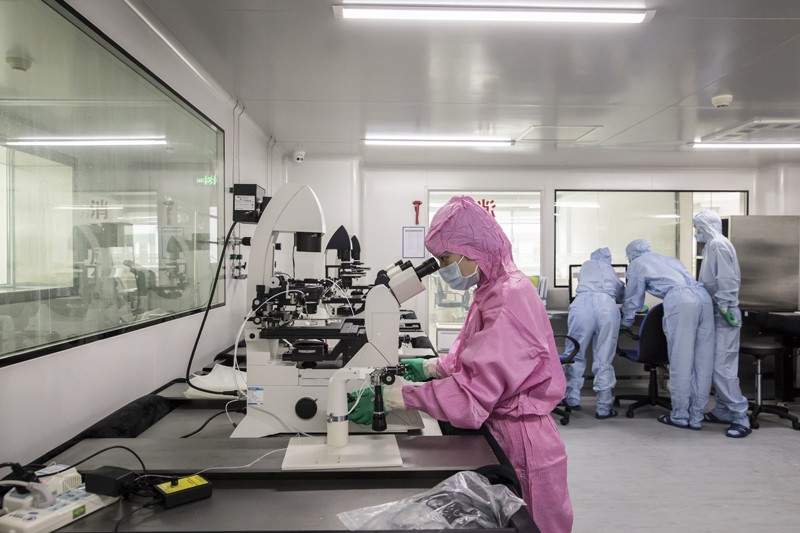The gap in research and development (R&D) funding between the United States and China is closing fast, despite modest increases in US funding since 2000, according to statistics assembled by the US National Science Foundation (NSF).
The United States is increasingly "seen globally as an important leader rather than the uncontested leader" in science and engineering, the agency said in the latest edition of its biennial Science and Engineering Indicators report, which compiles metrics on the state of science and engineering in the country.
From 2000 to 2017, R&D spending in the United States grew at an average of 4.3% per year, found the report, which the NSF released on 15 January. But spending in China grew by more than 17% per year during the same period. Several other countries, including Germany and South Korea, also increased their spending at rates that outstripped that of the United States, but they remain solidly behind the two global leaders in terms of total funding. The United States accounted for 25% of the US$2.2 trillion spent on R&D worldwide in 2017, and China made up 23%.
Preliminary data from 2019 suggest that China has already surpassed the United States in R&D spending, said Julia Philips, chair of the National Science Board's science and engineering policy committee, during a press briefing. The board oversees the NSF and produces the Indicators reports.
The emergence of other innovation powerhouses "can only be good", says Diane Souvaine, a computer scientist at Tufts University in Medford, Massachusetts. "New knowledge benefits everyone."
Souvaine, who chairs the National Science Board, notes that the United States still leads the world in many important metrics, such as total investment in R&D, proportion of highly cited publications and enrolment of internationally mobile students.
Julia Lane, an economist at New York University, objects to the NSF's use of spending as the pre-eminent metric for measuring the strength of the US science and engineering community. Instead of worrying about spending, she says, policymakers should be thinking about whether the dollars are being spent wisely. Lane also says that the continued attraction of foreign-born students and workers to the United States is "a good signal that good science is being done here".
Enrolment dip
But the NSF report found signs that this signal might be changing. The number of foreign-born students enrolling in US universities has declined by about 4% since 2016. And the retention rates for Chinese and Indian citizens who earn doctoral degrees in the United States have decreased by 9 and 5 percentage points, respectively, since 2003.
Shulamit Kahn, an economist at Boston University in Massachusetts, suspects that the tightening of US immigration policies, as well as increasingly strong university programmes in China and elsewhere, are the root causes of these declines.
At the same time, the global movement of researchers is opening up avenues for increased international scientific collaboration. Nearly 40% of scientific papers published by US authors in 2018 included foreign co-authors, up from 19% in 2000. Chinese scientists contributed to more than one-quarter of these manuscripts.
"The US–China relationship is the most important international scientific collaborative relationship we have right now," says Kei Koizumi, a former senior adviser in science policy at the American Association for the Advancement of Science in Washington DC. It's more appropriate, he continues, "to think of China as a collaborator than as an adversary".
Increasing diversity
The NSF report also found that US laboratories have become more diverse, by some measures. The participation of women and members of under-represented minorities in the science and engineering workforce has increased across the board since 2003, especially in the life sciences, psychology and the social sciences. However, because the total science and engineering workforce has also increased significantly over this period, the proportion of women in some disciplines, such as computer sciences and mathematics, has stagnated or even slightly decreased.
Molly King, a sociologist at Santa Clara University in California, says she is "not terribly surprised by any of the statistics" regarding diversity in the workforce. She cites several factors, including negative stereotyping and disparities in the rates at which women's papers are accepted and cited, which contribute to the persistence of the participation gap.
Furthermore, King says, owing to the differences in pay between science and engineering jobs and positions in other fields, this continued under-representation "has important implications for the gender (and racial) wage gaps and differential economic well-being". According to the Indicators report, the 2017 median salary for workers in science and engineering occupations was $85,390, more than double that for all workers ($37,690).
Koizumi thinks the report offers a clear road map of steps that the United States needs to take to remain competitive in global science and engineering: further investment in science, technology, engineering and maths education; increased inclusion of people from under-represented groups; and continued funding of science and engineering R&D. "It's all right there," he says.



No comments:
Post a Comment